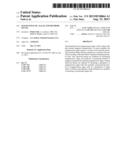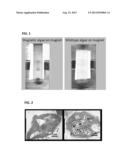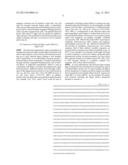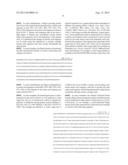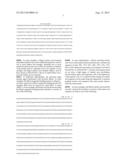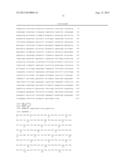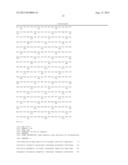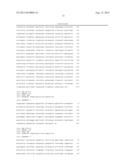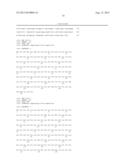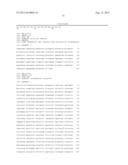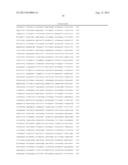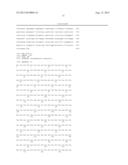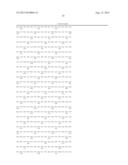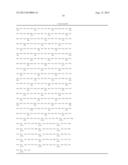Patent application title: MAGNETOTACTIC ALGAE AND METHODS OF USE
Inventors:
Pulak Nath (Los Alamos, NM, US)
Scott N. Twary (Santa Fe, NM, US)
Assignees:
Los Alamos National Security, LLC
IPC8 Class: AC12P764FI
USPC Class:
435 34
Class name: Measuring or testing process involving enzymes or micro-organisms; composition or test strip therefore; processes of forming such composition or test strip involving viable micro-organism determining presence or kind of micro-organism; use of selective media
Publication date: 2013-08-15
Patent application number: 20130210064
Abstract:
Disclosed herein are magnetotactic algae, such as algae cells that
include magnetic nanoparticles. In some examples the magnetotactic algae
express a nucleic acid molecule encoding a bacterial MagA ferrous
transporter, a nucleic acid molecule encoding a bacterial Mms6 magnetite
binding protein, or both. Also disclosed herein are methods for producing
magnetotactic algae and methods of producing biofuel or magnetic
nanoparticles utilizing magnetotactic algae. Further disclosed herein are
methods of enriching a population of magnetotactic algae cells (for
example, increasing the number of magnetotactic algae cells in a
population of algae cells). In further embodiments, disclosed herein are
methods of selecting a transformed algae cell.Claims:
1. A magnetotactic alga cell, comprising an alga cell expressing a
nucleic acid encoding a bacterial MagA ferrous transporter, a nucleic
acid encoding a bacterial Mms6 magnetite binding protein, or a
combination thereof.
2. The magnetotactic alga cell of claim 1, wherein the nucleic acid encoding the bacterial MagA ferrous transporter or the nucleic acid encoding the bacterial Mms6 magnetite binding protein is from Magnetospirillum magneticum.
3. The magnetotactic alga cell of claim 1, wherein the algal cell is Chlamydomonas, Nannochloropsis, Tetraselmis, Botryococcus, Chlorella, Dunaliella, Gracilaria, Pleurochrysis, or Sargassum.
4. A method of producing magnetotactic algae, comprising: transforming an alga cell with a nucleic acid encoding a bacterial MagA ferrous transporter, a nucleic acid encoding a bacterial Mms6 magnetite binding protein, or a combination thereof; and cultivating the transformed alga cell or progeny thereof that express the bacterial MagA ferrous transporter, the bacterial Mms6 magnetite binding protein, or both, under conditions sufficient to produce algae comprising magnetic nanoparticles, thereby producing magnetotactic algae.
5. The method of claim 4, further comprising magnetically collecting the algae comprising magnetic nanoparticles.
6. The method of claim 5, wherein magnetically collecting the algae comprising magnetic nanoparticles comprises enriching a population of magnetotactic algae cells.
7. The method of claim 4, wherein the nucleic acid encoding the bacterial MagA ferrous transporter or the nucleic acid encoding the bacterial Mms6 magnetite binding protein is from Magnetospirillum magneticum.
8. The method of claim 4, wherein the algal cell is Chlamydomonas, Nannochloropsis, Tetraselmis, Botryococcus, Chlorella, Dunaliella, Gracilaria, Pleurochrysis, or Sargassum.
9. The method of claim 4, wherein the conditions sufficient to produce algae comprising magnetic nanoparticles comprise a culture medium comprising at least about 25 μM Fe2+ salt.
10. A method of producing a product from algal cells, comprising: cultivating an alga cell expressing a nucleic acid encoding a bacterial MagA ferrous transporter, a nucleic acid encoding a bacterial Mms 6 magnetite binding protein, or a combination thereof, or progeny thereof that express the bacterial MagA ferrous transporter, the bacterial Mms6 magnetite binding protein, or both, under conditions sufficient to produce algae comprising magnetic nanoparticles; magnetically collecting the algae cells comprising magnetic nanoparticles; and isolating the product from the collected algae cells.
11. The method of claim 10, wherein the product comprises a lipid, and isolating the product from the collected algae cells comprises extracting lipid from the collected algae cells.
12. The method of claim 10, wherein the product comprises magnetic nanoparticles, and isolating the product from the collected algae cells comprises lysing the algae cells.
13. The method of claim 12, wherein lysing the algae comprises exposing the algae to an alternating magnetic field.
14. The method of claim 10, wherein the nucleic acid encoding the bacterial MagA ferrous transporter or the nucleic acid encoding the bacterial Mms6 magnetite binding protein is from Magnetospirillum magneticum.
15. The method of claim 10, wherein the algal cell is Chlamydomonas, Nannochloropsis, Tetraselmis, Botryococcus, Chlorella, Dunaliella, Gracilaria, Pleurochrysis, or Sargassum.
16. The method of claim 10, wherein the conditions sufficient to produce algae comprising magnetic nanoparticles comprise a culture medium comprising at least about 25 μM Fe2+ salt.
17. A method of selecting a transformed algal cell, comprising: cultivating a population of algae cells transformed with: a first nucleic acid molecule encoding a bacterial MagA ferrous transporter, a bacterial Mms 6 magnetite binding protein, or a combination thereof, and a second nucleic acid encoding a protein of interest, or progeny thereof that express the bacterial MagA ferrous transporter, the bacterial Mms6 magnetite binding protein, or both, under conditions sufficient to produce algae comprising magnetic nanoparticles; and magnetically collecting algae cells comprising magnetic nanoparticles, thereby selecting the transformed alga cell.
18. The method of claim 17, wherein the nucleic acid encoding the bacterial MagA ferrous transporter or the nucleic acid encoding the bacterial Mms6 magnetite binding protein is from Magnetospirillum magneticum.
19. The method of claim 17, wherein the algal cell is Chlamydomonas, Nannochloropsis, Tetraselmis, Botryococcus, Chlorella, Dunaliella, Gracilaria, Pleurochrysis, or Sargassum.
20. The method of claim 17, wherein the conditions sufficient to produce algae comprising magnetic nanoparticles comprise a culture medium comprising at least about 25 μM Fe2+ salt.
Description:
CROSS REFERENCE TO RELATED APPLICATION
[0001] This claims the benefit of U.S. Provisional Application No. 61/496,379, filed Jun. 13, 2011, which is incorporated by reference herein in its entirety.
FIELD
[0003] This disclosure relates to algae cells including magnetic nanoparticles and methods for their production and use.
BACKGROUND
[0004] There is continuing interest in the production of fuel from algae as an alternative energy source. However, commercial production of algal biofuel as a cost-competitive replacement for fossil fuel faces several technological barriers. Two key barriers are low cost algal harvesting and oil extraction. Harvesting and oil extraction account for about 30% of the total cost of production. Current technologies available for harvesting and extraction are either too expensive or not scalable for commercial production.
SUMMARY
[0005] Disclosed herein are magnetotactic algae, such as algae cells that include magnetic nanoparticles. In some examples the magnetotactic algae express a nucleic acid molecule encoding a bacterial MagA ferrous transporter (such as a Magnetospirillum magneticum MagA nucleic acid), a nucleic acid molecule encoding a bacterial Mms6 magnetite binding protein (such as a Magnetospirillum magneticum Mms6 nucleic acid), or both. In one example, the magnetotactic alga is a Chlamydomonas cell (such as C. reinhardtii), that expresses a bacterial MagA ferrous transporter and/or a bacterial Mms6 magnetite binding protein. In another example, the magnetotactic alga is a Nannochloropsis cell (such as Nannochloropsis salina) that expresses a bacterial MagA ferrous transporter and/or a bacterial Mms6 magnetite binding protein.
[0006] Also disclosed herein are methods for producing magnetotactic algae and methods of producing biofuel or magnetic nanoparticles utilizing magnetotactic algae. In some embodiments, the disclosed methods include methods of producing magnetotactic algae. The methods include transforming an alga cell with a nucleic acid molecule encoding a bacterial MagA ferrous transporter and/or a nucleic acid molecule encoding a bacterial Mms6 magnetite binding protein and cultivating the transformed alga cell and/or progeny thereof that express the bacterial MagA ferrous transporter, the bacterial Mms6 magnetite binding protein, or both, under conditions sufficient to produce algae cells including magnetic nanoparticles, thereby producing magnetotactic algae. In some examples, the methods further include collecting the algae including the magnetic nanoparticles, for example, magnetically collecting the algae.
[0007] Further disclosed herein are methods of enriching a population of magnetotactic algae cells (for example, increasing the number of magnetotactic algae cells in a population of algae cells). The methods include transforming an alga cell with a nucleic acid molecule encoding a bacterial MagA ferrous transporter and/or a nucleic acid molecule encoding a bacterial Mms6 magnetite binding protein, cultivating the transformed alga cell and/or progeny thereof that express the bacterial MagA ferrous transporter, the bacterial Mms6 magnetite binding protein, or both, under conditions sufficient to produce algae including magnetic nanoparticles, and magnetically collecting the algae including magnetic nanoparticles. In some examples, the magnetically collected algae are subsequently cultivated under conditions sufficient to produce algae including magnetic nanoparticles and magnetically collecting the algae cells including magnetic nanoparticles, further enriching the population of magnetotactic algae cells.
[0008] In some embodiments, disclosed herein are methods of producing biofuel. The methods include cultivating an alga cell expressing a nucleic acid molecule encoding a bacterial MagA ferrous transporter and/or a nucleic acid encoding a bacterial Mms6 magnetite binding protein, and/or progeny thereof, under conditions sufficient to produce algae including magnetic nanoparticles, magnetically collecting the algae including magnetic nanoparticles, and extracting lipid from the collected algae, thereby producing biofuel. In some examples, the methods include lysing the algae cell to extract lipid, for example by exposing the algae including magnetic nanoparticles to an alternating magnetic field.
[0009] In other embodiments, disclosed herein are methods of producing magnetic nanoparticles. The methods include cultivating an alga cell expressing a nucleic acid molecule encoding a bacterial MagA ferrous transporter and/or a nucleic acid encoding a bacterial Mms6 magnetite binding protein, and/or progeny thereof, under conditions sufficient to produce algae including magnetic nanoparticles, magnetically collecting the algae including magnetic nanoparticles, and isolating the magnetic nanoparticles from the collected algae. In some examples, the methods include lysing the algae cell to isolate the magnetic nanoparticles, for example by exposing the algae including magnetic nanoparticles to an alternating magnetic field.
[0010] In further embodiments, disclosed herein are methods of selecting a transformed algae cell. The methods include cultivating an alga cell transformed with a first nucleic acid molecule encoding a bacterial MagA ferrous transporter and/or a nucleic acid encoding a bacterial Mms6 magnetite binding protein, and/or progeny thereof that express the bacterial MagA ferrous transporter, the bacterial Mms6 magnetite binding protein, or both, under conditions sufficient to produce algae including magnetic nanoparticles, and magnetically collecting the algae comprising magnetic nanoparticles, thereby selecting the transformed algae cell. In some examples, the algae cell is further transformed with a second nucleic acid molecule encoding a protein of interest.
[0011] In some examples, the bacterial MagA ferrous transporter is a Magnetospirillum magneticum MagA ferrous transporter, for example encoded by a nucleic acid molecule including the sequence of SEQ ID NO: 1 or SEQ ID NO: 3. In additional examples, the bacterial Mms6 magnetite binding protein is a Magnetospirillum magneticum Mms6 magnetite binding protein, for example encoded by a nucleic acid molecule including the sequence set forth as SEQ ID NO: 4, SEQ ID NO: 5, or SEQ ID NO: 8. Exemplary algae of use in the disclosed compositions and methods include Chlamydomonas (such as C. reinhardtii), Nannochloropsis, Botryococcus, Chlorella, Dunaliella, Gracilaria, Pleurochrysis, or Sargassum.
[0012] The foregoing and other features of the disclosure will become more apparent from the following detailed description, which proceeds with reference to the accompanying figures.
BRIEF DESCRIPTION OF THE DRAWINGS
[0013] FIG. 1 is a digital image showing response of C. reinhardtii transformed with MagA (left) as compared to wild-type (non-transformed) algae (right). Transformed algae were cultured in liquid media including 100 μM ferrous sulfate. The magnet is behind the tube. Wild-type algae settled to the bottom of the tube, however, transformed algae did not settle, and were also drawn to the side of the tube closest to the magnet.
[0014] FIG. 2 is a pair of digital images of micrographs obtained by transmission electron microscopy of a wild-type (untransformed) Chlamydomonas reinhardtii cell (left) and a Chlamydomonas reinhardtii cell transformed with MagA (right). Aggregates of magnetic nanoparticles (circled) are visible in the transformed cell.
SEQUENCE LISTING
[0015] The nucleic acid and amino acid sequences listed herein are shown using standard letter abbreviations for nucleotide bases, and one letter code for amino acids.
[0016] Only one strand of each nucleic acid sequence is shown, but the complementary strand is understood as included by any reference to the displayed strand.
[0017] The Sequence Listing is submitted as an ASCII text file in the form of the file named Sequence_Listing.txt, which was created on Jun. 8, 2012, and is 27,115 bytes, which is incorporated by reference herein.
[0018] SEQ ID NOs: 1 and 2 are exemplary nucleic acid and amino acid sequences, respectively, of a Magnetospirillum magneticum AMB-1 MagA ferrous transporter.
[0019] SEQ ID NO: 3 is an exemplary nucleic acid sequence of a MagA ferrous transporter codon-optimized for Chlamydomonas. SEQ ID NOs: 4 and 5 are exemplary nucleic acid sequences of a Magnetospirillum magneticum AMB-1 Mms6 magnetite binding protein.
[0020] SEQ ID NOs: 6 and 7 are exemplary amino acid sequences of a Magnetospirillum magneticum AMB-1 Mms6 magnetite binding protein.
[0021] SEQ ID NO: 8 is an exemplary nucleic acid sequence of an Mms6 magnetite binding protein codon-optimized for Chlamydomonas.
[0022] SEQ ID NOs: 9 and 10 are exemplary nucleic acid and amino acid sequences, respectively, of a Chlamydomonas reinhardtii Fre1 ferrireductase.
DETAILED DESCRIPTION
[0023] Disclosed herein are magnetotactic algae which express one or more nucleic acids encoding proteins involved in iron uptake, metabolism, or production of magnetic nanoparticles. The disclosed algae can be rapidly and cost-effectively separated from a solution by application of a magnetic field (for example using a rare earth magnet), providing advantages in production of biofuels, wastewater treatment, and selection of genetically engineered algae. For example, harvesting of algae by conventional methods currently accounts for up to 15-20% of the overall cost of biofuel production from algae. By utilizing the disclosed magnetotactic algae, the algae can be harvested by magnetic separation, a low-cost, low-maintenance, and highly scalable separation method, which can reduce harvesting costs by up to 90%. Similarly, the disclosed magnetotactic algae can be used for wastewater treatment (for example, removal of heavy metals) and can be cost effectively removed from the treated water by magnetic separation. Finally, production of magnetic nanoparticles can be utilized as a selectable marker for transformed algal cells, for example, in place of conventional antibiotic resistance markers. Cells can be transformed with one or more of the nucleic acids disclosed herein and co-transformed with one or more additional nucleic acids of interest. Magnetic separation can be utilized to isolate transformed cells, eliminating problems associated with the natural antibiotic resistance of some algae, potential exposure to antibiotics or antibiotic resistance genes from cells or products, and the costs of antibiotics.
[0024] The disclosed algae are also useful for the production of magnetic nanoparticles, which can be isolated from the algae cells. The magnetic nanoparticles are suitable for many applications. These include biomedical applications, such as imaging (for example as MRI contrast agents) or therapeutic use (for example, tumor therapy by magnetic hyperthermia); electronics (for example, for high-density data storage); pigments; or as environmental catalysts (for example, for oxidation of carbon monoxide or oxidative pyrolysis of biomass). Production of magnetic nanoparticles by the disclosed biological methods is advantageous because it does not require the use of toxic precursors or organic solvents. In addition, use of algae to produce the magnetic nanoparticles does not require special growth conditions or oxygen concentrations (as is required for culture of anaerobic magnetotactic bacteria).
I. Terms
[0025] Unless otherwise noted, technical terms are used according to conventional usage. Definitions of common terms in molecular biology may be found in Benjamin Lewin, Genes V, published by Oxford University Press, 1994 (ISBN 0-19-854287-9); Kendrew et al. (eds.), The Encyclopedia of Molecular Biology, published by Blackwell Science Ltd., 1994 (ISBN 0-632-02182-9); and Robert A. Meyers (ed.), Molecular Biology and Biotechnology: a Comprehensive Desk Reference, published by VCH Publishers, Inc., 1995 (ISBN 1-56081-569-8).
[0026] Unless otherwise explained, all technical and scientific terms used herein have the same meaning as commonly understood by one of ordinary skill in the art to which this disclosure belongs. The singular terms "a," "an," and "the" include plural referents unless context clearly indicates otherwise. Similarly, the word "or" is intended to include "and" unless the context clearly indicates otherwise. It is further to be understood that all base sizes or amino acid sizes, and all molecular weight or molecular mass values, given for nucleic acids or polypeptides are approximate, and are provided for description. Although methods and materials similar or equivalent to those described herein can be used in the practice or testing of this disclosure, suitable methods and materials are described below. The term "comprises" means "includes." All publications, patent applications, patents, and other references mentioned herein are incorporated by reference in their entirety. In case of conflict, the present specification, including explanations of terms, will control. In addition, the materials, methods, and examples are illustrative only and not intended to be limiting.
[0027] In order to facilitate review of the various embodiments of the invention, the following explanations of specific terms are provided:
[0028] Algae: A group of autotrophic organisms which range from unicellular to multicellular forms. Unicellular algae are commonly referred to as microalgae. Microalgae include Achnanthes, Amphora, Borodinella, Botryococcus, Chaetoceros, Chlorococcum, Chlorella, Chlamydomonas, Cyclotella, Dunaliella, Pleurochrysis, Monoraphidium, Nannochloris, Nannochloropsis, Navicula, Nitzschia, Oocysitis, Oscillatoria, Phaeodactylum, Stichococcus, Synechococcus, Tetraselmis, and Thalassiosira. Macroalgae (seaweed) include Gracilaria and Sargassum. The singular form of algae is alga.
[0029] Cultivation: Intentional growth of an organism or cell, such as an alga (for example, Chlamydomonas or Nannochloropsis) in the presence of assimilable sources of carbon, nitrogen and mineral salts. In an example, such growth can take place in a solid or semi-solid nutritive medium, or in a liquid medium in which the nutrients are dissolved or suspended. In a further example, the cultivation may take place on a surface or by submerged culture. The nutritive medium can be composed of complex nutrients or can be chemically defined.
[0030] Heterologous: Originating from a different genetic sources or species. A gene that is heterologous to an alga cell originates from an organism or species other than the algal cell in which it is expressed. In one specific, non-limiting example, a heterologous MagA or Mms6 gene includes a Magnetospirillum magneticum gene which is expressed in an algal cell (for example a Chlamydomonas cell). Methods for introducing a heterologous gene into an alga cell are well known in the art, for example transformation with a nucleic acid, including electroporation, lipofection, and particle gun acceleration.
[0031] Isolated: An "isolated" component (such as a magnetic nanoparticle, nucleic acid molecule, protein, or cell) has been substantially separated or purified away from other components in the cell of the organism, or the organism itself, in which the component occurs, such as other chromosomal and extra-chromosomal DNA and RNA, proteins and cells. Magnetic nanoparticles that have been "isolated" include magnetic nanoparticles purified by standard purification methods. For example, an isolated magnetic nanoparticle can be a magnetic nanoparticle that is substantially separated from other cell components.
[0032] MagA: A bacterial ferrous (Fe2+) transporter. Nucleic acid and protein sequences for MagA are publicly available. For example, GenBank Accession No. NC--007626 (nucleotides 4400031 to 4401335; SEQ ID NO: 1) provides an exemplary Magnetospirillum magneticum AMB-1 MagA nucleic acid sequence, and GenBank Accession No. YP--423353 (SEQ ID NO: 2) provides an exemplary MagA protein sequence; both of these publicly available sequences are incorporated by reference as provided in GenBank on Jun. 13, 2011. Additional MagA sequences are available, for example from additional Magnetospirillum magneticum strains (such as strain MGT-1) or from Magnetospirillum magnetotacticum (such as strain MS-1) and can be identified by one of ordinary skill in the art.
[0033] In one example, MagA includes a full-length wild-type (or native) sequence, as well as MagA allelic variants that retain ferrous transporter activity. In certain examples, MagA has at least 80% sequence identity, for example at least 85%, 90%, 95%, or 98% sequence identity to a publicly available MagA sequence, such as those disclosed herein.
[0034] Magnetic nanoparticle: A nanoparticle containing magnetite (Fe2O3). In some examples, a magnetic nanoparticle is produced by a living cell, such as a bacterial or algal cell. In some examples, a magnetic nanoparticle produced by a living cell is included in an organelle in a cell (for example, a magnetosome). However, formation of a magnetosome is not required for formation of magnetic nanoparticles.
[0035] Magnetotactic: Orienting in a magnetic field along the magnetic field lines. Magnetotactic algae are algae that include intracellular magnetic nanoparticles and are capable of orienting along magnetic field lines. Magnetotactic cells (such as magnetotactic algae cells) can be collected magnetically, for example, collected based on application of or exposure to a magnetic field.
[0036] Mms6: A bacterial protein tightly associated with magnetite crystals. Mms6 is believed to play a role in regulation of magnetite crystal size and morphology in magnetotactic bacteria (e.g., Tanaka et al., J. Biol. Chem. 286:6386-6392, 2011). Nucleic acid and protein sequences for Mms6 are publicly available. For example, GenBank Accession Nos. AB096081 (SEQ ID NO: 4) and NC--007626 (nucleotides 1016676-1017149; SEQ ID NO: 5) provide exemplary Magnetospirillum magneticum AMB-1 Mms6 nucleic acid sequences, and GenBank Accession Nos. BAC65162 (SEQ ID NO: 6) and YP--420319 (SEQ ID NO: 7) provide exemplary Mms6 protein sequences; all of these publicly available sequences are incorporated by reference as provided in GenBank on Jun. 8, 2012. Additional Mms6 sequences are available, for example from additional Magnetospirillum magneticum strains (such as strain MGT-1) or from Magnetospirillum gryphiswaldense and can be identified by one of ordinary skill in the art.
[0037] In one example, Mms6 includes a full-length wild-type (or native) sequence, as well as Mms6 allelic variants that retain magnetic particle binding activity. In certain examples, Mms6 has at least 80% sequence identity, for example at least 85%, 90%, 95%, or 98% sequence identity to a publicly available Mms6 sequence, such as those disclosed herein.
[0038] Purified: The term "purified" does not require absolute purity; rather, it is intended as a relative term. Thus, for example, a purified magnetic nanoparticle preparation is one in which the magnetic nanoparticle is more pure than the magnetic nanoparticle in its environment within a cell. For example, a preparation of magnetic nanoparticles is purified such that the magnetic nanoparticle represents at least 50% of the total content of the preparation.
[0039] Tesla (T): Tesla is the SI derived unit of magnetic field B, also known as "magnetic flux density." One tesla is equal to one weber per square meter.
[0040] Transduced and Transformed: A virus or vector "transduces" a cell when it transfers nucleic acid into the cell. A cell is "transformed" by a nucleic acid transduced into the cell when the DNA becomes stably replicated by the cell, either by incorporation of the nucleic acid into the cellular genome, or by episomal replication. As used herein, the term transformation encompasses all techniques by which a nucleic acid molecule is introduced into such a cell, including transformation with plasmid vectors, and introduction of naked DNA by electroporation, lipofection, and particle gun acceleration.
III. Overview of Several Embodiments
[0041] Disclosed herein are magnetotactic algae and methods of making and using such algae. In some examples the magnetotactic algae express a nucleic acid molecule encoding a bacterial MagA ferrous transporter (such as a Magnetospirillum magneticum MagA nucleic acid, for example SEQ ID NO: 1 or SEQ ID NO: 3). In other examples, the magnetotactic algae express a nucleic acid encoding a bacterial Mms6 magnetite binding protein (such as a Magnetospirillum magneticum Mms6 magnetite binding protein, for example SEQ ID NO: 4, SEQ ID NO: 5, or SEQ ID NO: 8). In still further examples, the magnetotactic algae express both a nucleic acid encoding a bacterial MagA ferrous transporter and a nucleic acid encoding a bacterial Mms6 magnetite binding protein. Without being bound by theory, it is believed that heterologous expression of a bacterial MagA ferrous transporter in algal cells facilitates iron uptake by the algae cells, permitting formation of magnetic nanoparticles, for example in magnetosomes, as compared to in the absence of a MagA expression. Further, again without being bound by theory, it is believed that heterologous expression of a bacterial Mms6 magnetite binding protein in algal cells facilitates formation of more magnetic nanoparticles, larger magnetic nanoparticles, and/or magnetic nanoparticles with more regular crystal structures than in the absence of Mms6 expression. In one example, the magnetotactic alga cell is a Chlamydomonas cell (such as C. reinhardtii), that expresses a bacterial MagA ferrous transporter, a bacterial Mms6 magnetite binding protein, or both. In another example, the magnetotactic algae are a Nannochloropsis cell (such as Nannochloropsis salina) that expresses a bacterial MagA ferrous transporter, a bacterial Mms6 magnetite binding protein, or both.
[0042] Magnetotactic algae are useful for a variety of applications, including production of biofuels and production of magnetic nanoparticles, for example for biomedical use. The disclosed magnetotactic algae can be magnetically harvested (for example, commercially available permanent magnet-based filters or rare earth magnets). The magnetotactic algae may also be lysed using magnetic hyperthermia to release lipids and/or the magnetic nanoparticles contained in the cells. The lipids can be used for biofuel production. The magnetic nanoparticles can be used for medical applications, such as MRI, cancer treatment or targeted drug delivery. In addition, biologically produced magnetic nanoparticles have superior magnetic properties compared to those produced by chemical synthesis methods. See, e.g., Prozorov et al., Adv. Funct. Mater. 17:951-957, 2007; Xie et al., Nano. Res. 2:261-278, 2009.
[0043] Also disclosed herein are methods for producing magnetotactic algae. The methods include transforming an alga cell with a nucleic acid molecule encoding a bacterial MagA ferrous transporter, a nucleic acid molecule encoding a bacterial Mms6 magnetite binding protein, or both and cultivating the transformed alga cell and/or progeny thereof that express the bacterial MagA ferrous transporter, the bacterial Mms6 magnetite binding protein, or both, under conditions sufficient to produce algae cells including magnetic nanoparticles, thereby producing magnetotactic algae. In some examples, the methods further include collecting the algae including the magnetic nanoparticles, for example, magnetically collecting the algae.
[0044] Further disclosed herein are methods of enriching a population of magnetotactic algae cells (for example, increasing the number of magnetotactic algae cells in a population of algae cells). The methods include transforming an alga cell with a nucleic acid molecule encoding a bacterial MagA ferrous transporter, a nucleic acid molecule encoding bacterial Mms6 magnetite binding protein, or both, cultivating the transformed alga cell and/or progeny thereof that express the bacterial MagA ferrous transporter, the bacterial Mms6 magnetite binding protein, or both, under conditions sufficient to produce algae including magnetic nanoparticles, and magnetically collecting the algae including magnetic nanoparticles. In some examples, the magnetically collected algae are subsequently cultivated under conditions sufficient to produce algae including magnetic nanoparticles and magnetically collecting the algae cells including magnetic nanoparticles, further enriching the population of magnetotactic algae cells.
[0045] In some embodiments, disclosed herein are methods of producing biofuel. The methods include cultivating an alga cell expressing a nucleic acid molecule encoding a bacterial MagA ferrous transporter, a nucleic acid molecule encoding a bacterial Mms6 magnetite binding protein, or both, and/or progeny thereof under conditions sufficient to produce algae including magnetic nanoparticles, magnetically collecting the algae including magnetic nanoparticles, and extracting lipid from the collected algae, thereby producing biofuel. In some examples, the methods include lysing the algae cell to extract lipid, for example by exposing the algae including magnetic nanoparticles to an alternating magnetic field.
[0046] In other embodiments, disclosed herein are methods of producing magnetic nanoparticles. The methods include cultivating an alga cell expressing a nucleic acid molecule encoding a bacterial MagA ferrous transporter, a nucleic acid molecule encoding a bacterial Mms6 magnetite binding protein, or both, and/or progeny thereof under conditions sufficient to produce algae including magnetic nanoparticles, magnetically collecting the algae including magnetic nanoparticles, and isolating the magnetic nanoparticles from the collected algae, thereby producing biofuel. In some examples, the methods include lysing the algae cell to isolate the magnetic nanoparticles, for example by exposing the algae including magnetic nanoparticles to an alternating magnetic field.
[0047] In further embodiments, disclosed herein are methods of selecting a transformed algae cell. The methods include cultivating an alga cell transformed with a first nucleic acid molecule encoding a bacterial MagA ferrous transporter, a nucleic acid molecule encoding a bacterial Mms6 magnetite binding protein, or both and/or progeny thereof that express the bacterial MagA ferrous transporter, the bacterial Mms6 magnetite binding protein, or both, under conditions sufficient to produce algae including magnetic nanoparticles, and magnetically collecting the algae comprising magnetic nanoparticles, thereby selecting the transformed algae cell. In some examples, the algae cell is further transformed with a second nucleic acid molecule encoding a protein of interest.
[0048] The disclosed methods of selecting a population of transformed cells and/or enriching a population of cells by magnetic collection are not limited to algal cells. Any cell type (for example, bacterial, fungal, plant, or mammalian cells) can be transformed with a bacterial MagA ferrous transporter and/or a bacterial Mms6 magnetite binding protein in order to produce magnetotactic cells. The methods disclosed herein with respect to algal cells can equally be applied to other cell types, with modifications for the transformation and culture of specific cell types, as is known to one of ordinary skill in the art.
III. Expression of Bacterial MagA and/or Mms6 in Algae Cells
[0049] The disclosed magnetotactic algae and methods of making and using such algae include algae transformed with and/or expressing one or more nucleic acid molecules encoding one or more bacterial genes relating to iron transport and/or metabolism. In one embodiment, the gene encodes a bacterial MagA ferrous transporter. In another embodiment, the gene encodes a magnetite binding protein, such as bacterial Mms6. In additional embodiments, Mms6 is used in combination with MagA to produce the magnetotactic algae disclosed herein. Additional nucleic acids encoding components of the magnetosome are known to one of skill in the art (see, e.g., Xie et al., Nano. Res. 2:261-278, 2009; Prozorov et al., Adv. Funct. Mater. 17:951-957, 2007). In addition, nucleic acids encoding other iron metabolism related proteins (for example, Fre1, Fea1, and/or Fea2) could be used in combination with MagA and/or Mms6 to produce the magnetotactic algae disclosed herein. In some examples, an algal nucleic acid encoding a ferrireductase of Chlamydomonas such as Fre1 (see, e.g., Allen et al., Eukaryotic Cell 6:1841-1852, 2007) is overexpressed in the disclosed algal cells expressing MagA and/or Mms6, to reduce ferric iron in solution and facilitate uptake of ferrous iron. Fre1 nucleic acid and amino acid sequences are publicly available. GenBank Accession No. XM--001692181; SEQ ID NO: 9) provides an exemplary Chlamydomonas FRE1 nucleic acid sequence, and GenBank Accession No. XP--001692233 (SEQ ID NO: 10) provides an exemplary Chlamydomonas Fre1 protein sequence; both of these publicly available sequences are incorporated by reference as provided in GenBank on Jun. 8, 2012. In one example, Fre1 includes a full-length wild-type (or native) sequence, as well as Fre1 allelic variants that retain ferrireductase activity. In certain examples, Fre1 has at least 80% sequence identity, for example at least 85%, 90%, 95%, or 98% sequence identity to a publicly available Fre1 sequence, such as those disclosed herein.
[0050] In some embodiments, the disclosed algae include algae transformed with a bacterial ferrous transporter, such as a bacterial MagA nucleic acid. In some examples, the MagA ferrous transporter is a Magnetospirillum magneticum MagA ferrous transporter (for example, MagA from M. magneticum strain MS-1 or strain AMB-1). In one example, the nucleic acid molecule encoding the MagA ferrous transporter includes or consists of:
TABLE-US-00001 (SEQ ID NO: 1) ATGGAACTGCATCATCCCGAACTGACCTATGCCGCCATCGTCGCCCTGGCCGCCGTGCTGTGCG GCGGGATGATGACGCGCCTGAAGCAGCCGGCCGTCGTCGGCTACATCCTGGCGGGGGTGGTGCT GGGACCCAGCGGCTTCGGGCTGGTGAGCAACCGCGACGCCGTGGCCACCCTGGCCGAGTTCGGC GTGCTGATGCTGCTGTTCGTCATCGGCATGAAGCTGGACATCATCCGCTTTCTCGAAGTGTGGA AGACGGCCATCTTCACCACGGTTCTGCAGATCGCCGGCAGCGTGGGCACGGCCCTGCTGCTGCG TCACGGCCTGGGCTGGAGCCTGGGGCTGGCGGTGGTGCTGGGCTGTGCCGTGGCGGTGTCGTCC ACCGCCGTAGTGATCAAGGTGCTGGAATCCTCGGACGAGCTGGACACGCCGGTCGGCCGCACCA CCCTTGGCATCCTGATCGCCCAGGACATGGCGGTGGTGCCCATGATGCTGGTGCTGGAATCCTT CGAGACCAAGGCGCTGCTGCCCGCCGACATGGCCCGGGTGGTGCTGTCGGTGCTGTTCCTGGTG CTGCTGTTCTGGTGGCTGTCCAAGCGCCGCATCGACCTGCCGATCACCGCCCGGCTTTCCCGCG ATTCTGACCTTGCCACCCTGTCGACCCTGGCCTGGTGTTTCGGCACCGCCGCCATCTCCGGCGT GCTGGACTTGTCGCCGGCCTATGGCGCCTTCCTGGGCGGCGTGGTGCTGGGCAATTCCGCCCAG CGCGACATGCTGTTGAAGCGTGCCCAGCCCATCGGCAGCGTGCTGCTGATGGTGTTCTTCCTGT CCATCGGGCTGCTGCTCGACTTCAAGTTCATCTGGAAGAATCTGGGCACCGTTCTCACCCTGCT GGCCATGGTGACCCTGTTCAAGACGGCGCTGAACGTCACGGCGCTGCGCCTGGCGCGGCAGGAC TGGCCCAGCGCCTTCCTGGCCGGCGTGGCCCTGGCCCAGATCGGCGAGTTCTCGTTCCTGCTGG CCGAGACCGGCAAGGCGGTCAAGCTGATCAGCGCCCAGGAGACCAAGCTGGTGGTGGCGGTCAC CGTGCTGTCCCTGGTGCTGTCGCCGTTCTGGCTGTTCACCATGCGGCGCATGCACCGGGTGGCG GCGGTGCATGTCCATTCGTTCCGCGATCTGGTCACGCGGCTGTATGGCGACGAGGCCCGCGCTT TCGCCCGCACCGCGCGGCGGGCCCGTGTGCTGGTGCGGCGTGGTTCCTGGAGGGATGACCCCAA TGCCGGACCTGGCTCTGGAATTTGA
[0051] In some embodiments, a MagA encoding nucleic acid of use in the methods disclosed herein has a nucleic acid sequence at least 70%, 75%, 85%, 90%, 95%, 96%, 97%, 98% or 99% identical to the nucleic acid sequence set forth in SEQ ID NO: 1. Nucleic acid sequences that do not show a high degree of identity may nevertheless encode similar amino acid sequences, due to the degeneracy of the genetic code. It is understood that changes in nucleic acid sequence can be made using this degeneracy to produce multiple nucleic acid sequences that each encode substantially the same protein.
[0052] In some examples, the MagA nucleic acid molecule encodes a protein that includes or consists of the amino acid sequence set forth as:
TABLE-US-00002 (SEQ ID NO: 2) MELHHPELTYAAIVALAAVLCGGMMTRLKQPAVVGYILAGVVLGPSGFGLVSNRDAVATLAEFG VLMLLFVIGMKLDIIRFLEVWKTAIFTTVLQIAGSVGTALLLRHGLGWSLGLAVVLGCAVAVSS TAVVIKVLESSDELDTPVGRTTLGILIAQDMAVVPMMLVLESFETKALLPADMARVVLSVLFLV LLFWWLSKRRIDLPITARLSRDSDLATLSTLAWCFGTAAISGVLDLSPAYGAFLGGVVLGNSAQ RDMLLKRAQPIGSVLLMVFFLSIGLLLDFKFIWKNLGTVLTLLAMVTLFKTALNVTALRLARQD WPSAFLAGVALAQIGEFSFLLAETGKAVKLISAQETKLVVAVTVLSLVLSPFWLFTMRRMHRVA AVHVHSFRDLVTRLYGDEARAFARTARRARVLVRRGSWRDDPNAGPGSGI
[0053] In some embodiments, the MagA polypeptide has an amino acid sequence at least 80%, 85%, 90%, 95%, 96%, 97%, 98% or 99% identical to the amino acid sequence set forth in SEQ ID NO: 2.
[0054] In some examples, the heterologous gene is codon-optimized for the cell in which it is to be expressed. Codon usage bias, the use of synonymous codons at unequal frequencies, is ubiquitous among genetic systems (Ikemura, J. Mol. Biol. 146:1-21, 1981; Ikemura, J. Mol. Biol. 158:573-97, 1982). The strength and direction of codon usage bias is related to genomic G+C content and the relative abundance of different isoaccepting tRNAs (Akashi, Curr. Opin. Genet. Dev. 11:660-666, 2001; Duret, Curr. Opin. Genet. Dev. 12:640-9, 2002; Osawa et al., Microbiol. Rev. 56:229-264, 1992). Codon usage can affect the efficiency of gene expression. Codon-optimization refers to replacement of a codon in a nucleic acid sequence with a synonymous codon (one that codes for the same amino acid) more frequently used (preferred) in the organism. Each organism has a particular codon usage bias for each amino acid, which can be determined from publicly available codon usage tables (for example see Nakamura et al., Nucleic Acids Res. 28:292, 2000 and references cited therein). For example, a codon usage database is available on the World Wide Web at kazusa.or.jp/codon. One of skill in the art can modify a nucleic acid encoding a particular amino acid sequence, such that it encodes the same amino acid sequence, while being optimized for expression in a particular cell type (such as an algae cell).
[0055] In some examples, the methods disclosed herein include a MagA ferrous transporter nucleic acid that has been codon-optimized for algae (such as Chlamydomonas or Nannochloropsis). In one example, a codon-optimized MagA nucleic acid (codon-optimized for Chlamydomonas) includes or consists of the following sequence:
TABLE-US-00003 (SEQ ID NO. 3) CTATCTAGAGGATCCCCGGGTGGTCTCTTGACCatggagctgcaccaccccgagctgacctacg ccgccatcgtggccctggccgccgtgctgtgcggcggcatgatgacccgcctgaagcagcccgc cgtggtgggctacatcctggccggcgtggtgctgggccccagcggcttcggcctggtgagcaac cgcgacgccgtggccaccctggccgagttcggcgtgctgatgctgctgttcgtgatcggcatga agctggacatcatccgcttcctggaggtgtggaagaccgccatcttcaccaccgtgctgcagat cgccggcagcgtgggcaccgccctgctgctgcgccacggcctgggctggagcctgggcctggcc gtggtgctgggctgcgccgtggccgtgagcagcaccgccgtggtgatcaaggtgctggagagca gcgacgagctggacacccccgtgggccgcaccaccctgggcatcctgatcgcccaggacatggc cgtggtgcccatgatgctggtgctggagagcttcgagaccaaggccctgctgcccgccgacatg gcccgcgtggtgctgagcgtgctgttcctggtgctgctgttctggtggctgagcaagcgccgca tcgacctgcccatcaccgcccgcctgagccgcgacagcgacctggccaccctgagcaccctggc ctggtgcttcggcaccgccgccatcagcggcgtgctggacctgagccccgcctacggcgccttc ctgggcggcgtggtgctgggcaacagcgcccagcgcgacatgctgctgaagcgcgcccagccca tcggcagcgtgctgctgatggtgttcttcctgagcatcggcctgctgctggacttcaagttcat ctggaagaacctgggcaccgtgctgaccctgctggcgatggtgaccctgttcaagaccgccctg aacgtgaccgccctgcgcctggcccgccaggactggcccagcgccttcctggccggcgtggccc tggcccagatcggcgagttcagcttcctgctggccgagaccggcaaggccgtgaagctgatcag cgcccaggagaccaagctggtggtggccgtgaccgtgctgagcctggtgctgagccccttctgg ctgttcaccatgcgccgcatgcaccgcgtggccgccgtgcacgtgcacagcttccgcgacctgg tgacccgcctgtacggcgacgaggcccgcgccttcgcccgcaccgcccgccgcgcccgcgtgct ggtgcgccgcggcagctggcgcgacgaccccaacgccggccccggcagcggcatcTAAGCTAGC GTGTGAATTGGTGACCCGAGCTCGAATTTC.
[0056] In some examples, a MagA nucleic acid molecule optionally includes one or more additional sequences, such as one or more linkers (for example, including one or more restriction enzyme sites) for to allow for insertion or deletion of the nucleic acid in a plasmid vector, for example. In one example, the MagA nucleic acid includes linkers, such as those shown in SEQ ID NO: 3 above in capital letters; however, the linkers are not required.
[0057] In additional embodiments, the disclosed algae include algae transformed with bacterial Mms6. In some examples, the Mms6 magnetite binding protein is a Magnetospirillum magneticum Mms6 magnetite binding protein (for example, Mms from M. magneticum strain MS-1 or strain AMB-1). In one example, the nucleic acid molecule encoding the Mms6 magnetite binding protein includes or consists of one of the following:
TABLE-US-00004 (SEQ ID NO: 4) ATGGGCGAGATGGAGCGCGAGGGCGCCGCCGCCAAGGCCGGGGCTGCCAAGACGGGCGCCGCCA AGACCGGAACCGTCGCCAAGACCGGCATCGCCGCCAAGACGGGTGTTGCCACCGCCGTTGCCGC TCCGGCGGCTCCTGCCAATGTTGCCGCCGCCCAGGGCGCCGGGACCAAGGTCGCCCTTGGCGCG GGCAAGGCCGCCGCCGGTGCCAAGGTCGTCGGTGGAACCATCTGGACCGGTAAGGGGCTGGGCC TCGGTCTGGGTCTCGGTCTGGGCGCGTGGGGGCCGATCATTCTCGGCGTTGTTGGCGCCGGGGC GGTTTACGCRTATATGAAGAGCCGTGATATCGAATCGGCGCAGAGCGACGAGGAAGTCGAACTG CGCGACGCGCTGGCCTGA (SEQ ID NO: 5) GTGCCAGCTCAGATCGCCAACGGAGTTATTTGCCCCCCAGGGGCCCCGGCCGGAACCAAGGCCG CCGCCGCCATGGGCGAGATGGAGCGCGAGGGCGCCGCCGCCAAGGCCGGGGCTGCCAAGACGGG CGCCGCCAAGACCGGAACCGTCGCCAAGACCGGCATCGCCGCCAAGACGGGTGTTGCCACCGCC GTTGCCGCTCCGGCGGCTCCTGCCAATGTTGCCGCCGCCCAGGGCGCCGGGACCAAGGTCGCCC TTGGCGCGGGCAAGGCCGCCGCCGGTGCCAAGGTCGTCGGTGGAACCATCTGGACCGGTAAGGG GCTGGGCCTCGGTCTGGGTCTCGGTCTGGGCGCGTGGGGGCCGATCATTCTCGGCGTTGTTGGC GCCGGGGCGGTTTACGCGTATATGAAGAGCCGTGATATCGAATCGGCGCAGAGCGACGAGGAAG TCGAACTGCGCGACGCGCTGGCCTGA
[0058] In some embodiments, a Mms6 encoding nucleic acid of use in the methods disclosed herein has a nucleic acid sequence at least 70%, 75%, 85%, 90%, 95%, 96%, 97%, 98% or 99% identical to the nucleic acid sequence set forth in SEQ ID NO: 4 or SEQ ID NO: 5. Nucleic acid sequences that do not show a high degree of identity may nevertheless encode similar amino acid sequences, due to the degeneracy of the genetic code. It is understood that changes in nucleic acid sequence can be made using this degeneracy to produce multiple nucleic acid sequences that each encode substantially the same protein.
[0059] In some examples, the Mms6 nucleic acid molecule encodes a protein that includes or consists of the amino acid sequence set forth as one of the following:
TABLE-US-00005 (SEQ ID NO: 6) MGEMEREGAAAKAGAAKTGAAKTGTVAKTGIAAKTGVATAVAAPAAPANVAAAQGAGTKVALGA GKAAAGAKVVGGTIWTGKGLGLGLGLGLGAWGPIILGVVGAGAVYAYMKSRDIESAQSDEEVEL RDALA (SEQ ID NO: 7) MPAQIANGVICPPGAPAGTKAAAAMGEMEREGAAAKAGAAKTGAAKTGTVAKTGIAAKTGVATA VAAPAAPANVAAAQGAGTKVALGAGKAAAGAKVVGGTIWTGKGLGLGLGLGLGAWGPIILGVVG AGAVYAYMKSRDIESAQSDEEVELRDALA
[0060] In some embodiments, the Mms6 polypeptide has an amino acid sequence at least 80%, 85%, 90%, 95%, 96%, 97%, 98% or 99% identical to the amino acid sequence set forth in SEQ ID NO: 6 or SEQ ID NO: 7.
[0061] In some examples, the heterologous gene is codon-optimized for the cell in which it is to be expressed, as discussed above with respect to MagA. One of skill in the art can modify a nucleic acid encoding a particular amino acid sequence, such that it encodes the same amino acid sequence, while being optimized for expression in a particular cell type (such as an algae cell). In some examples, the methods disclosed herein include a Mms6 nucleic acid that has been codon-optimized for algae (such as Chlamydomonas or Nannochloropsis). In one example, a codon-optimized MagA nucleic acid (codon-optimized for Chlamydomonas) includes or consists of the following sequence:
TABLE-US-00006 (SEQ ID NO: 8) ATGGGCGAGATGGAGCGCGAGGGCGCCGCCGCCAAGGCCGGCGCCGCCAAGACCGGCGCCGCCA AGACCGGCACCGTGGCCAAGACCGGCATCGCCGCCAAGACCGGCGTGGCCACCGCCGTGGCCGC CCCCGCCGCCCCCGCCAACGTGGCCGCCGCCCAGGGCGCCGGCACCAAGGTGGCCCTGGGCGCC GGCAAGGCCGCCGCCGGCGCCAAGGTGGTGGGCGGCACCATCTGGACCGGCAAGGGCCTGGGCC TGGGCCTGGGCCTGGGCCTGGGCGCCTGGGGCCCCATCATCCTGGGCGTGGTGGGCGCCGGCGC CGTGTACGCCTACATGAAGAGCCGCGACATCGAGAGCGCCCAGAGCGACGAGGAGGTGGAGCTG CGCGACGCCCTGGCC
[0062] In further embodiments, the disclosed algae include algae transformed with a bacterial ferrous transporter and a bacterial magnetite binding protein. In some examples, the algae are transformed with a nucleic acid encoding a Magnetospirillum magneticum MagA ferrous transporter (such as SEQ ID NO: 1 or SEQ ID NO: 3) and a nucleic acid encoding a Magnetospirillum magneticum Mms6 magnetic particle binding protein (such as SEQ ID NO: 4, SEQ ID NO: 5, or SEQ ID NO: 8). In other examples, algae are transformed with a nucleic acid at least 70% identical (for example, at least 75%, 80%, 85%, 90%, 95%, 96%, 97%, 98% or 99% identical) to the nucleic acid sequence set forth as SEQ ID NO: 1 or SEQ ID NO:3 and a nucleic acid at least 70% identical (for example, at least 75%, 80%, 85%, 90%, 95%, 96%, 97%, 98% or 99% identical) to the nucleic acid sequence set forth as SEQ ID NO: 4, SEQ ID NO: 5, or SEQ ID NO: 8. In additional embodiments, the algae are further transformed with an algal Fre1 ferrireductase nucleic acid, such as SEQ ID NO: 9, or a nucleic acid at least 70% identical (for example, at least 75%, 80%, 85%, 90%, 95%, 96%, 97%, 98% or 99% identical) to SEQ ID NO: 10.
[0063] Methods of transforming algae are known in the art. In an embodiment, a nucleic acid molecule can be inserted into one or more expression vectors, using methods known to those of skill in the art. Vectors include one or more expression cassettes including expression control sequences operably linked to the nucleic acid of interest (such as MagA, Mms6, Fre1, or other nucleic acids). An expression cassette includes nucleic acid elements that permit expression of a gene in a host cell. Typically, the expression cassette includes a promoter that is functional in the selected host system that is operably linked to the gene to be expressed. The promoter can be constitutive or inducible. In an embodiment, the expression cassette includes a promoter, ribosome binding site, a start codon (ATG) if necessary, and optionally a region encoding a leader peptide in addition to the desired DNA molecule and stop codon. In addition, a 3' terminal region (translation and/or transcription terminator) can be included within the cassette. The heterologous nucleic acid constituted in the DNA molecule may be solely controlled by the promoter so that transcription and translation occur in the host cell. In one example, the nucleic acid is placed under the control of the strong constitutive PSAD promoter. Additional constitutive promoters suitable for use in algae cell transformation include the ribulose bisphosphate carboxylase (RBCS2) promoter or the HSP70A-RBCS2 tandem promoter. Inducible promoters of use in algae cell transformation include NIT1 (ammonium starvation-induced), CA1 (low CO2-induced), and CYC6 (induced by copper depletion or nickel or cobalt addition) promoters.
[0064] The presence of additional regulatory sequences within the expression cassette may be desirable to allow for regulation of expression of the nucleic acid relative to the growth of the host cell. These regulatory sequences are well known in the art. Examples of regulatory sequences include sequences that turn gene expression on or off in response to chemical or physical stimulus as well as enhancer sequences. In addition, to the regulatory sequences, selectable markers can be included to assist in selection of transformed cells. For example, genes that confer antibiotic resistance or sensitivity to the plasmid may be used as selectable markers.
[0065] Transformation of an alga cell with recombinant DNA can be carried out by conventional techniques as are well known to those of ordinary skill in the art. Methods of transformation include transformation utilizing Agrobacterium tumifaciens transformed with a plasmid including the desired nucleic acid, such as MagA, Mms6, and/or FRE1 (for example, a pCAMBIA vector). Other methods include biolistics (e.g., a "gene gun"), for example utilizing a pSL18 plasmid including the nucleic acid. In other examples, algae cells can be transformed utilizing electroporation, glass beads, or carbide whiskers. One of ordinary skill in the art can select an appropriate transformation method and vector, based on the cells to be transformed and other desired characteristics.
[0066] A wide variety of algae species (such as microalgae and/or macroalgae) can be utilized in the methods described herein. In some examples, the algae species include, but are not limited to Chlorella (such as Chlorella vulgaris), Chlamydomonas (such as Chlamydomonas reinhardtii), Chaetoceros, Spirulina (such as Spirulina platensis), Dunaliella, and Porphyridum. In particular examples, the algae species include algae useful for production of biofuels or other compounds (such as polyunsaturated acids, pigments, or phytochemicals, for example, for nutritional supplements). In some examples, the algae include Akistrodesmus, Arthrospira, Botryococcus braunii, Chlorella (such as Chlorella sp. or Chlorella protothecoides), Crypthecodinium (such as Crypthecodinium cohnii), Cyclotella, Dunaliella tertiolecta, Gracilaria, Hantzschia, Haematococcus (such as Haematococcus Nannochloris, Nannochloropsis, Neochloris oleoabundans, Nitzschia, Phaeodactylum, Pleurochrysis carterae (also called CCMP647), Porphyridium, Sargassum, Scenedesmus (such as Scenedesmus obliquus), Schiochytrium, Stichococcus, Tetraselmis, Thalassiosira pseudonana, Thraustochytrium roseum, and Ulkenia sp. In one example, the algae species is Chlamydomonas reinhardtii. In another example, the algae cells are Nannochloropsis salina. In another example, the algae cells are Tetraselmis striata.
IV. Cultivation, Collection, and Lysis of Magnetotactic Algae
[0067] The algae cells disclosed herein which have been transformed with a nucleic acid molecule encoding a bacterial MagA ferrous transporter and/or a bacterial Mms6 magnetite binding protein, or which express a nucleic acid encoding a bacterial MagA ferrous transporter and/or a bacterial Mms6 magnetite binding protein are cultivated under conditions sufficient to produce algae including magnetic nanoparticles.
[0068] Methods of cultivating algae are well known to one of ordinary skill in the art. The magnetotactic algae of the present disclosure can be cultured in conventional fermentation bioreactors, which include, but are not limited to, batch, fed-batch, cell recycle, and continuous fermenters. The cultivation can also be conducted in shake flasks, test tubes, microtiter dishes, or petri plates. The algae can also be cultivated in outdoor open ponds. Cultivation of the algae is carried out at a temperature, pH and oxygen content appropriate for the particular recombinant algae species. Such culturing conditions are well within the expertise of one of ordinary skill in the art.
[0069] In some examples, the algae are cultivated in a liquid medium with shaking, such as tris-acetate phosphate medium. The algae can be grown on a standard light/dark regimen, for example about 16 hours light and 8 hours dark alternating. In some examples, the liquid medium is supplemented with Fe2+ (such as ferrous citrate, ferrous sulfate, or ferrous chloride) in an amount sufficient for the algae to take up iron and form magnetic nanoparticles. In some examples, the liquid medium includes about 10 μM to about 500 μM ferrous salt (such as about 20 μM to about 250 μM, about 50 μM to about 200 μM, or about 100 μM to 200 μM). In other examples, the liquid medium is not supplemented with iron, for example if the algae are transformed with or overexpress an algal Fre1 ferrireductase, which in some examples permits reduction of ferric iron naturally present in the water source to be reduced to the ferrous form and thus available for uptake by the algae cells. In one non-limiting example, the algae expressing a nucleic acid encoding a bacterial MagA ferrous transporter are cultured in tris-acetate phosphate media supplemented with 100 μM ferrous sulfate. In some examples, the algae are cultured in the liquid medium for about 12 hours or more, for example, about 12, hours, 24 hours, 36 hours, 48 hours, 60 hours, 72 hours, 84 hours, 96 hours, or more. In further examples, the algae are cultured for about 1 day to about 10 days, such as about 1, 2, 3, 4, 5, 6, 7, 8, 9, or 10 days. In one example, the algae are cultured for at least 24 hours.
[0070] Algae containing magnetic particles, such as those cultured in conditions described above, can be magnetically collected due to the presence of magnetic nanoparticles in the algae cells. Magnetic collection or separation can be carried out in a continuous flow, allowing processing of large volumes. In some examples, a high gradient magnetic sorter is used. In other examples, an open gradient magnetic sorter is used. The use of permanent magnets can substantially reduce energy consumption of the process, as compared to electromagnets. In some examples, a magnetic sorter is utilized to collect the algae which contain magnetic nanoparticles. In some examples, the algae are collected with a magnetic field of about 0.3 to 2.0 T (for example, about 0.5 to about 1.0 T, about 1.0 to about 2.0 T, for example about 2.0 T with a linear gradient). Commercial permanent magnet-based systems are available and are capable of processing up to 1000 liters/minute (e.g., magnetic filters available from Eclipse Magnetics, Sheffield, UK). However, any form of magnetic collection or separation can be utilized.
[0071] In some embodiments, the methods include lysing the algae cells to extract lipid (for example for biofuel production) or to isolate the magnetic nanoparticles (for example for use in medical, electronic, or chemical applications). Methods of lysing algae cells are known to one of skill in the art and include sonication or mechanical disruption (for example using a French press or glass beads). In the disclosed methods, algae cells including magnetic nanoparticles can also be lysed by exposing the cells to an alternating magnetic field, thereby creating localized heating (magnetic hyperthermia). Methods of producing magnetic hyperthermia in single-cell organisms (such as bacteria) are known to one of skill in the art (e.g., Timko et al., J. Magnetism Magnetic Mater. 321:1521-1524, 2009). In some examples, magnetic hyperthermia is produced utilizing a system including a sine-wave power oscillator and an induction coil, which is placed around a vessel containing the algae sample. In one example, magnetic hyperthermia is produced at a frequency of 750 kHz vs. AC-field amplitude of 0 to about 5 kA/m (such as about 0.25, 0.5, 0.75, 1.0, 1.25, 1.5, 1.75, 2.0, 2.5, 3.0, 3.5, 4.0, 4.5, or 5.0 kA/m).
[0072] Methods of extracting lipid from cells (such as algae) are well known to one of ordinary skill in the art. Suitable methods include, but are not limited to hexane solvent extraction, Soxhlet extraction, supercritical fluid extraction, extraction/expeller press, and ultrasonic-assisted extraction. See, e.g., Brennan and Owende, Renewable and Sustainable Energy Reviews 14:557-577, 2010.
[0073] In some embodiments, the methods further include isolating magnetic nanoparticles from the lysed algae cells. In some examples, the cells are disrupted by physical or chemical means. A magnetic sorter can then be utilized to sort or collect the magnetic particles from the lysed samples. Conventional methods of collecting magnetic nanoparticles can be used. Magnetic separators are commercially available, for example, from Dynal (Invitrogen, Carlsbad, Calif.), Polysciences (Warrington, Pa.), and Sigris Research (Brea, Calif.).
[0074] The following examples are provided to illustrate certain particular features and/or embodiments. These examples should not be construed to limit the invention to the particular features or embodiments described.
EXAMPLES
Example 1
Production of Magnetotactic Algae
[0075] Chlamydomonas reinhardtii strain 1690 was transformed by a biolistic method with pSL18 plasmid including a nucleic acid molecule encoding MagA bacterial ferrous transporter (SEQ ID NO: 3). Transformants were selected using paramomycin. The transformed cells were cultured in tris-acetate phosphate (TAP) medium, and in TAP supplemented with 100 μM Fe2+. Liquid cultures were grown under 16 hour light/8 hour dark regimen, shaken at 120 rpm. A range of iron concentrations (10 μM to 200 μM) and iron salts were tested.
[0076] Production of magnetic nanoparticles by the transformed cells was tested by placing the culture next to a magnet and observing whether the cells were attracted to the magnet. In general, cells cultured with 10 μM Fe2+ did not respond to the external magnet, cells cultured with 25 μM Fe2+ showed a weak response, cells cultured with 50 μM Fe2+ showed a moderate effect, and cells cultured with 100 μM or 200 μM Fe2+ showed similar greatest effects. An example of the response of transformed Chlamydomonas cells grown in liquid medium including 100 μM ferrous sulfate to the external magnet is shown in FIG. 1. Similar results were obtained with transformed Nannochloropsis and Tetraselmis cells.
[0077] Transmission electron microscopy was used to visualize accumulation of magnetic nanoparticles in the transformed Chlamydomonas cells. The transformed cells included aggregates of nanoparticles within the cells (FIG. 2). The nanoparticles were estimated to have a diameter of about 10 nm.
Example 2
Magnetic Collection of Magnetotactic Algae
[0078] Algae including magnetic nanoparticles (such as those described in Example 1) are magnetically collected. The liquid culture containing the magnetotactic algae is passed through a high gradient magnetic sorter (HGMS) in a continuous flow. The algae are exposed to a magnetic field gradient. Algae containing magnetic nanoparticles are retained in the HGMS and the liquid medium and other non-magnetic components pass through in the flow-through.
[0079] Alternatively, algae including magnetic nanoparticles (such as those described in Example 1) are magnetically collected. The liquid culture containing the magnetotactic algae is passed through an open gradient magnetic sorter (OGMS) in a continuous flow. The algae are exposed to a magnetic field gradient. Algae containing magnetic nanoparticles are deflected in the flow and separated from the liquid medium and other non-magnetic components.
Example 3
Cell Lysis by Magnetic Hyperthermia
[0080] Algae including magnetic nanoparticles (such as those described in Example 1) are lysed by magnetic hyperthermia. The liquid culture containing the magnetotactic algae, or the collected magnetotactic algae (for example, collected as described in Example 2) are placed in a system including a sine-wave power oscillator and a vessel containing the algae, which is wound in an induction coil. The sample is heated by exposing the algae to a frequency of 750 kHz versus an AC-field amplitude of about 2.5 kA/m. The heating of the algae from the alternating magnetic field results in lysis of the cells. Lipid or magnetic nanoparticles or both can then be isolated from the lysed cells. Magnetic particles are collected using a magnetic sorter. Lipids are collected by standard methods in the art, such as organic extraction.
[0081] In view of the many possible embodiments to which the principles of the disclosure may be applied, it should be recognized that the illustrated embodiments are only examples and should not be taken as limiting the scope of the invention. Rather, the scope of the invention is defined by the following claims. We therefore claim as our invention all that comes within the scope and spirit of these claims.
Sequence CWU
1
1
1011305DNAMagnetospirillum magneticum 1atggaactgc atcatcccga actgacctat
gccgccatcg tcgccctggc cgccgtgctg 60tgcggcggga tgatgacgcg cctgaagcag
ccggccgtcg tcggctacat cctggcgggg 120gtggtgctgg gacccagcgg cttcgggctg
gtgagcaacc gcgacgccgt ggccaccctg 180gccgagttcg gcgtgctgat gctgctgttc
gtcatcggca tgaagctgga catcatccgc 240tttctcgaag tgtggaagac ggccatcttc
accacggttc tgcagatcgc cggcagcgtg 300ggcacggccc tgctgctgcg tcacggcctg
ggctggagcc tggggctggc ggtggtgctg 360ggctgtgccg tggcggtgtc gtccaccgcc
gtagtgatca aggtgctgga atcctcggac 420gagctggaca cgccggtcgg ccgcaccacc
cttggcatcc tgatcgccca ggacatggcg 480gtggtgccca tgatgctggt gctggaatcc
ttcgagacca aggcgctgct gcccgccgac 540atggcccggg tggtgctgtc ggtgctgttc
ctggtgctgc tgttctggtg gctgtccaag 600cgccgcatcg acctgccgat caccgcccgg
ctttcccgcg attctgacct tgccaccctg 660tcgaccctgg cctggtgttt cggcaccgcc
gccatctccg gcgtgctgga cttgtcgccg 720gcctatggcg ccttcctggg cggcgtggtg
ctgggcaatt ccgcccagcg cgacatgctg 780ttgaagcgtg cccagcccat cggcagcgtg
ctgctgatgg tgttcttcct gtccatcggg 840ctgctgctcg acttcaagtt catctggaag
aatctgggca ccgttctcac cctgctggcc 900atggtgaccc tgttcaagac ggcgctgaac
gtcacggcgc tgcgcctggc gcggcaggac 960tggcccagcg ccttcctggc cggcgtggcc
ctggcccaga tcggcgagtt ctcgttcctg 1020ctggccgaga ccggcaaggc ggtcaagctg
atcagcgccc aggagaccaa gctggtggtg 1080gcggtcaccg tgctgtccct ggtgctgtcg
ccgttctggc tgttcaccat gcggcgcatg 1140caccgggtgg cggcggtgca tgtccattcg
ttccgcgatc tggtcacgcg gctgtatggc 1200gacgaggccc gcgctttcgc ccgcaccgcg
cggcgggccc gtgtgctggt gcggcgtggt 1260tcctggaggg atgaccccaa tgccggacct
ggctctggaa tttga 13052434PRTMagnetospirillum magneticum
2Met Glu Leu His His Pro Glu Leu Thr Tyr Ala Ala Ile Val Ala Leu1
5 10 15Ala Ala Val Leu Cys Gly
Gly Met Met Thr Arg Leu Lys Gln Pro Ala 20 25
30Val Val Gly Tyr Ile Leu Ala Gly Val Val Leu Gly Pro
Ser Gly Phe 35 40 45Gly Leu Val
Ser Asn Arg Asp Ala Val Ala Thr Leu Ala Glu Phe Gly 50
55 60Val Leu Met Leu Leu Phe Val Ile Gly Met Lys Leu
Asp Ile Ile Arg65 70 75
80Phe Leu Glu Val Trp Lys Thr Ala Ile Phe Thr Thr Val Leu Gln Ile
85 90 95Ala Gly Ser Val Gly Thr
Ala Leu Leu Leu Arg His Gly Leu Gly Trp 100
105 110Ser Leu Gly Leu Ala Val Val Leu Gly Cys Ala Val
Ala Val Ser Ser 115 120 125Thr Ala
Val Val Ile Lys Val Leu Glu Ser Ser Asp Glu Leu Asp Thr 130
135 140Pro Val Gly Arg Thr Thr Leu Gly Ile Leu Ile
Ala Gln Asp Met Ala145 150 155
160Val Val Pro Met Met Leu Val Leu Glu Ser Phe Glu Thr Lys Ala Leu
165 170 175Leu Pro Ala Asp
Met Ala Arg Val Val Leu Ser Val Leu Phe Leu Val 180
185 190Leu Leu Phe Trp Trp Leu Ser Lys Arg Arg Ile
Asp Leu Pro Ile Thr 195 200 205Ala
Arg Leu Ser Arg Asp Ser Asp Leu Ala Thr Leu Ser Thr Leu Ala 210
215 220Trp Cys Phe Gly Thr Ala Ala Ile Ser Gly
Val Leu Asp Leu Ser Pro225 230 235
240Ala Tyr Gly Ala Phe Leu Gly Gly Val Val Leu Gly Asn Ser Ala
Gln 245 250 255Arg Asp Met
Leu Leu Lys Arg Ala Gln Pro Ile Gly Ser Val Leu Leu 260
265 270Met Val Phe Phe Leu Ser Ile Gly Leu Leu
Leu Asp Phe Lys Phe Ile 275 280
285Trp Lys Asn Leu Gly Thr Val Leu Thr Leu Leu Ala Met Val Thr Leu 290
295 300Phe Lys Thr Ala Leu Asn Val Thr
Ala Leu Arg Leu Ala Arg Gln Asp305 310
315 320Trp Pro Ser Ala Phe Leu Ala Gly Val Ala Leu Ala
Gln Ile Gly Glu 325 330
335Phe Ser Phe Leu Leu Ala Glu Thr Gly Lys Ala Val Lys Leu Ile Ser
340 345 350Ala Gln Glu Thr Lys Leu
Val Val Ala Val Thr Val Leu Ser Leu Val 355 360
365Leu Ser Pro Phe Trp Leu Phe Thr Met Arg Arg Met His Arg
Val Ala 370 375 380Ala Val His Val His
Ser Phe Arg Asp Leu Val Thr Arg Leu Tyr Gly385 390
395 400Asp Glu Ala Arg Ala Phe Ala Arg Thr Ala
Arg Arg Ala Arg Val Leu 405 410
415Val Arg Arg Gly Ser Trp Arg Asp Asp Pro Asn Ala Gly Pro Gly Ser
420 425 430Gly
Ile31374DNAArtificial SequenceMagA sequence codon-optimized for
Chlamydomonas 3ctatctagag gatccccggg tggtctcttg accatggagc tgcaccaccc
cgagctgacc 60tacgccgcca tcgtggccct ggccgccgtg ctgtgcggcg gcatgatgac
ccgcctgaag 120cagcccgccg tggtgggcta catcctggcc ggcgtggtgc tgggccccag
cggcttcggc 180ctggtgagca accgcgacgc cgtggccacc ctggccgagt tcggcgtgct
gatgctgctg 240ttcgtgatcg gcatgaagct ggacatcatc cgcttcctgg aggtgtggaa
gaccgccatc 300ttcaccaccg tgctgcagat cgccggcagc gtgggcaccg ccctgctgct
gcgccacggc 360ctgggctgga gcctgggcct ggccgtggtg ctgggctgcg ccgtggccgt
gagcagcacc 420gccgtggtga tcaaggtgct ggagagcagc gacgagctgg acacccccgt
gggccgcacc 480accctgggca tcctgatcgc ccaggacatg gccgtggtgc ccatgatgct
ggtgctggag 540agcttcgaga ccaaggccct gctgcccgcc gacatggccc gcgtggtgct
gagcgtgctg 600ttcctggtgc tgctgttctg gtggctgagc aagcgccgca tcgacctgcc
catcaccgcc 660cgcctgagcc gcgacagcga cctggccacc ctgagcaccc tggcctggtg
cttcggcacc 720gccgccatca gcggcgtgct ggacctgagc cccgcctacg gcgccttcct
gggcggcgtg 780gtgctgggca acagcgccca gcgcgacatg ctgctgaagc gcgcccagcc
catcggcagc 840gtgctgctga tggtgttctt cctgagcatc ggcctgctgc tggacttcaa
gttcatctgg 900aagaacctgg gcaccgtgct gaccctgctg gcgatggtga ccctgttcaa
gaccgccctg 960aacgtgaccg ccctgcgcct ggcccgccag gactggccca gcgccttcct
ggccggcgtg 1020gccctggccc agatcggcga gttcagcttc ctgctggccg agaccggcaa
ggccgtgaag 1080ctgatcagcg cccaggagac caagctggtg gtggccgtga ccgtgctgag
cctggtgctg 1140agccccttct ggctgttcac catgcgccgc atgcaccgcg tggccgccgt
gcacgtgcac 1200agcttccgcg acctggtgac ccgcctgtac ggcgacgagg cccgcgcctt
cgcccgcacc 1260gcccgccgcg cccgcgtgct ggtgcgccgc ggcagctggc gcgacgaccc
caacgccggc 1320cccggcagcg gcatctaagc tagcgtgtga attggtgacc cgagctcgaa
tttc 13744402DNAMagnetospirillum magneticum 4atgggcgaga
tggagcgcga gggcgccgcc gccaaggccg gggctgccaa gacgggcgcc 60gccaagaccg
gaaccgtcgc caagaccggc atcgccgcca agacgggtgt tgccaccgcc 120gttgccgctc
cggcggctcc tgccaatgtt gccgccgccc agggcgccgg gaccaaggtc 180gcccttggcg
cgggcaaggc cgccgccggt gccaaggtcg tcggtggaac catctggacc 240ggtaaggggc
tgggcctcgg tctgggtctc ggtctgggcg cgtgggggcc gatcattctc 300ggcgttgttg
gcgccggggc ggtttacgcr tatatgaaga gccgtgatat cgaatcggcg 360cagagcgacg
aggaagtcga actgcgcgac gcgctggcct ga
4025474DNAMagnetospirillum magneticum 5gtgccagctc agatcgccaa cggagttatt
tgccccccag gggccccggc cggaaccaag 60gccgccgccg ccatgggcga gatggagcgc
gagggcgccg ccgccaaggc cggggctgcc 120aagacgggcg ccgccaagac cggaaccgtc
gccaagaccg gcatcgccgc caagacgggt 180gttgccaccg ccgttgccgc tccggcggct
cctgccaatg ttgccgccgc ccagggcgcc 240gggaccaagg tcgcccttgg cgcgggcaag
gccgccgccg gtgccaaggt cgtcggtgga 300accatctgga ccggtaaggg gctgggcctc
ggtctgggtc tcggtctggg cgcgtggggg 360ccgatcattc tcggcgttgt tggcgccggg
gcggtttacg cgtatatgaa gagccgtgat 420atcgaatcgg cgcagagcga cgaggaagtc
gaactgcgcg acgcgctggc ctga 4746133PRTMagnetospirillum magneticum
6Met Gly Glu Met Glu Arg Glu Gly Ala Ala Ala Lys Ala Gly Ala Ala1
5 10 15Lys Thr Gly Ala Ala Lys
Thr Gly Thr Val Ala Lys Thr Gly Ile Ala 20 25
30Ala Lys Thr Gly Val Ala Thr Ala Val Ala Ala Pro Ala
Ala Pro Ala 35 40 45Asn Val Ala
Ala Ala Gln Gly Ala Gly Thr Lys Val Ala Leu Gly Ala 50
55 60Gly Lys Ala Ala Ala Gly Ala Lys Val Val Gly Gly
Thr Ile Trp Thr65 70 75
80Gly Lys Gly Leu Gly Leu Gly Leu Gly Leu Gly Leu Gly Ala Trp Gly
85 90 95Pro Ile Ile Leu Gly Val
Val Gly Ala Gly Ala Val Tyr Ala Tyr Met 100
105 110Lys Ser Arg Asp Ile Glu Ser Ala Gln Ser Asp Glu
Glu Val Glu Leu 115 120 125Arg Asp
Ala Leu Ala 1307157PRTMagnetospirillum magneticum 7Met Pro Ala Gln Ile
Ala Asn Gly Val Ile Cys Pro Pro Gly Ala Pro1 5
10 15Ala Gly Thr Lys Ala Ala Ala Ala Met Gly Glu
Met Glu Arg Glu Gly 20 25
30Ala Ala Ala Lys Ala Gly Ala Ala Lys Thr Gly Ala Ala Lys Thr Gly
35 40 45Thr Val Ala Lys Thr Gly Ile Ala
Ala Lys Thr Gly Val Ala Thr Ala 50 55
60Val Ala Ala Pro Ala Ala Pro Ala Asn Val Ala Ala Ala Gln Gly Ala65
70 75 80Gly Thr Lys Val Ala
Leu Gly Ala Gly Lys Ala Ala Ala Gly Ala Lys 85
90 95Val Val Gly Gly Thr Ile Trp Thr Gly Lys Gly
Leu Gly Leu Gly Leu 100 105
110Gly Leu Gly Leu Gly Ala Trp Gly Pro Ile Ile Leu Gly Val Val Gly
115 120 125Ala Gly Ala Val Tyr Ala Tyr
Met Lys Ser Arg Asp Ile Glu Ser Ala 130 135
140Gln Ser Asp Glu Glu Val Glu Leu Arg Asp Ala Leu Ala145
150 1558399DNAArtificial SequenceMms6 sequence
codon-optimized for Chlamydomonas 8atgggcgaga tggagcgcga gggcgccgcc
gccaaggccg gcgccgccaa gaccggcgcc 60gccaagaccg gcaccgtggc caagaccggc
atcgccgcca agaccggcgt ggccaccgcc 120gtggccgccc ccgccgcccc cgccaacgtg
gccgccgccc agggcgccgg caccaaggtg 180gccctgggcg ccggcaaggc cgccgccggc
gccaaggtgg tgggcggcac catctggacc 240ggcaagggcc tgggcctggg cctgggcctg
ggcctgggcg cctggggccc catcatcctg 300ggcgtggtgg gcgccggcgc cgtgtacgcc
tacatgaaga gccgcgacat cgagagcgcc 360cagagcgacg aggaggtgga gctgcgcgac
gccctggcc 39993974DNAChlamydomonas reinhardtii
9acattctctg ttcgcgacag gacaacgtcc ggcgagaacg cagatcaagt cggtcgggcc
60ggtctacaac aacggtcgcg acagcacttc ttcgccgccc cgtccgccta caacaacggc
120agccgagaga gccatcttaa gtgcaaatca gtttactgct ggtgctgtca agatggggcc
180cactccaagc tgggctgcgc gcggacgcgc tgcggtggcg ctcagtgcgt ccctgttctt
240tcagctcctg gtcttggcgg gctgtgcaac attcgcattc ttcatgtttg tgacgcccac
300ccgctggtac ctcgtccgcg aagccgagtt catagcctgg cgcaactccc tcatcctgcc
360ctacaccttc atcaacggca ccaccggccg caccacccct ctgctgagtg ggaccataag
420ctggctggtt atctggcaat ggaccacaac cctggcggcg gcgctgggtg ccgcgggcct
480gttgtgggtg gcctccctca actccgcctc ttcccccact cccaataaga gttcgtcttc
540caagcgcccg caggcatgct ggtccctggg acgcgcaatt aaaagggccc tcacccgtgc
600ccgtcgcgtg ctgcaccacc cgctgcctcc ccgtggcatg tggcgcacgc tgtttggccc
660cgggggcctg agcgtcctgg acatgttctt gatcctgttc tggtttgcga tccacgccat
720gtggatgtac gagatgacca tgcgtgtctt ggacaaccgc cgtgccaacc cgccgccgcc
780ccgaccccgc agccctcctc cagcctccgc cgcccggcca cttcccgccg catccaccag
840ctcctccacc aacgcctccg cctccagcgg caccgcgtcc tctcccaggc ccgccgcccg
900tctcctgcta ggcgccaccc acagccgcac cctcctccag tcccagtccc agtcccagtc
960cgcctacccg ccgccgccca agtccgccaa cagcaccaag gccgccgcgc ccccgccgcc
1020aaccgtgcgg aggctgaagc ccctgcccga agtcgtacag gacagtgtcg ccaagtactc
1080tggctgggtg ggccgcctgg acctgctgct gctgttcttc cctctgccgc gctgcaactt
1140cctgcactgg ctgctgggga gcgacttccc caccttggtc aagtaccaca ggtggttggg
1200ccacggcacg atgctgatca actccatcca cggcatcgta tacatgggca tgtgggccaa
1260cgccggcacc ctgacgacca tgctgaattg gggcatgggc gccggcgtca atcgtcttgc
1320tggcctcatc tcgctgtgcg gcggctggct cctttggatc acctgcatcc ccatcattcg
1380caggcgcttc ttcaacgttt tctacatcag ccacatcctc ggcgcgatca tatttcttct
1440gttcggcttc atgcaccgca aggacgtggc cacctgggtc atgccgggca tcttcctgta
1500ccttctcgat gtggtgctgc ggaccatcca gcagtgcttc aacgcgacgc gcgtgtctct
1560cgttgcatct cctgccgaca ctcctgcaag catcaagcgc gccgtcatgt ccatgcccca
1620gggcggcagc ggcggtgtgg ctgcgagcct gtcccgtgac ggcggcgtgc tgaccctcac
1680catcccctgc gaccagtcca tgacctggtg tggcggcgac atcgtgttcc tgaacctgcc
1740ctgtgtcagc tggtggcagt ggcacccctt caccatcgcc aacacctccg ctacctttga
1800ccaccccgcc gccgccacac cctcgcccgg cgccgagccc cacttcgcca aggactccag
1860catgtcctcc accagcgcct catcgggtgc cgcggctgcc gccgcctccg gtgcacgtgt
1920gcgctacatg caggtgcaca tcaagaagta caatgcctgg acccggagcc tcatcaaaca
1980gctggaagct tccggcggcg cctcctccct ggccctgtac gtcagcggcc cctaccatcc
2040gcccaccctc accggctcca acagctacag ccgccgcctg gtgaacggct tccggcgcca
2100cgtcttcatt gcgggcggca ttggggtcac acccgccctg ggaatgatcc aggagctgat
2160tgccgcacgc cgcaacacca acaccaacaa caacaccaac aacaccaaca ccggcaccaa
2220tgacgacaag gcccacggcc gcgtgacgtt cgtgtgggtg agccgcagcg ctgacgagct
2280ggaggcggtg ctaccggccg aggtgctgga ggaggccaac cggggcaagg acggttggct
2340tgacatgcag ctctacatca ccggcagtag caacaacagc aacagcaagg ccgccgccgc
2400ctcggcaatc acggtggacg ttgccgcgga cgcaaacacc gccgccggag ccgccgacgc
2460ctcggctgct gccgctgccg aggccaagct cgccagcctc accccggcgt tctctcgctc
2520ctatgcgacc ttcagccacg ctctgtcagg cctcagcggc cttcgccgca gtggcagcaa
2580cagcagcagc ggcgacattg gcagtggcct ggccggcggc ttctttggct ttcgctccgt
2640gtgggacccg gtggccgcgg ttgtcttcct gcccggatac ctgctggtgc ttgcggccgg
2700tgccgtgcgg tgggcggcgt ttggagccgt caaggccagg cctctggctc acccctacat
2760cgcgggtggg ccgctgatgt gggcggtggc tgtggtgctg tgcttcgcgg gcggcttcgg
2820cggactcatc accgcacagt cgtacgacgg ttacgccgcc cgtacggtgg cggtgcggtc
2880ggactactcg tatgtgggca tgctgcagtt tgcggcgctg ggtgtgggcg cggtgctggg
2940acccgcgctg ctggccctgg tgatgcacgc catgtgcagg cttctcagcc tgaagaggcg
3000caccgccaac gtaaccgaaa tggagtcaca gccttccgcc tcaggctccg acgcctcgcc
3060cgctgactgc cgcatcggcg tcacggtcac agctggcacc aacgccgcca ccggtgctgc
3120ctccaaggct ctggccgcgc cgccgccggc tcacgtgccc accgccgccg cctacatcag
3180caccggacgc cccgacctca agaccatcct cacgcacgcc gccgcgccct acgccccgga
3240cggtgaggcg gttgaggatg accaggccgc tgctgtgggc gttttcgtgg ccgggccggc
3300ccctctggtg gcggctgtgg cggacacgtg cgctgctgtg aacggtgtgt gggctgcgct
3360gtttggcggc tgctgcggtg gcggtgtggg tggccgtgct tacctggagc tgcacgcgct
3420gacgcatgag ctgtagagtg catgcgggta catgacgtag gctgggtgct ggcggagtgg
3480tggtggagcg tgctggagca ctcactttgc gggcaatcag tgacgaacgg tgacggtgcg
3540tggtggcgat ggtgatgggt gctatatata agtaaggcga gcggctgttt atttatcgca
3600ctgctgccgt cggacggagc gaggaggcaa caggttgtgg cccatagaag tcatgagtgt
3660gcgcaccagc agtgaagcct tccatttagc gcaaccttgc ttgcttgcat gctatctaca
3720catacacatg cttggcggcg gttaggtaca gtgtcccgtc cctacctccg ttgtgggcac
3780tgtgcgtgtt tgctgctggt gttttgggcg tgaaaagcga gtgcgtggga atacatgggg
3840catgcagtgg ccagaccaag tgccaggccc catgccccga aacctccctc gcggggacaa
3900gcgatcccct cacggaaccc taaaacctgg ttgtttaggg gttaaacccc ctccctgtaa
3960taccaaagtg ctgc
3974101087PRTChlamydomonas reinhardtii 10Met Gly Pro Thr Pro Ser Trp Ala
Ala Arg Gly Arg Ala Ala Val Ala1 5 10
15Leu Ser Ala Ser Leu Phe Phe Gln Leu Leu Val Leu Ala Gly
Cys Ala 20 25 30Thr Phe Ala
Phe Phe Met Phe Val Thr Pro Thr Arg Trp Tyr Leu Val 35
40 45Arg Glu Ala Glu Phe Ile Ala Trp Arg Asn Ser
Leu Ile Leu Pro Tyr 50 55 60Thr Phe
Ile Asn Gly Thr Thr Gly Arg Thr Thr Pro Leu Leu Ser Gly65
70 75 80Thr Ile Ser Trp Leu Val Ile
Trp Gln Trp Thr Thr Thr Leu Ala Ala 85 90
95Ala Leu Gly Ala Ala Gly Leu Leu Trp Val Ala Ser Leu
Asn Ser Ala 100 105 110Ser Ser
Pro Thr Pro Asn Lys Ser Ser Ser Ser Lys Arg Pro Gln Ala 115
120 125Cys Trp Ser Leu Gly Arg Ala Ile Lys Arg
Ala Leu Thr Arg Ala Arg 130 135 140Arg
Val Leu His His Pro Leu Pro Pro Arg Gly Met Trp Arg Thr Leu145
150 155 160Phe Gly Pro Gly Gly Leu
Ser Val Leu Asp Met Phe Leu Ile Leu Phe 165
170 175Trp Phe Ala Ile His Ala Met Trp Met Tyr Glu Met
Thr Met Arg Val 180 185 190Leu
Asp Asn Arg Arg Ala Asn Pro Pro Pro Pro Arg Pro Arg Ser Pro 195
200 205Pro Pro Ala Ser Ala Ala Arg Pro Leu
Pro Ala Ala Ser Thr Ser Ser 210 215
220Ser Thr Asn Ala Ser Ala Ser Ser Gly Thr Ala Ser Ser Pro Arg Pro225
230 235 240Ala Ala Arg Leu
Leu Leu Gly Ala Thr His Ser Arg Thr Leu Leu Gln 245
250 255Ser Gln Ser Gln Ser Gln Ser Ala Tyr Pro
Pro Pro Pro Lys Ser Ala 260 265
270Asn Ser Thr Lys Ala Ala Ala Pro Pro Pro Pro Thr Val Arg Arg Leu
275 280 285Lys Pro Leu Pro Glu Val Val
Gln Asp Ser Val Ala Lys Tyr Ser Gly 290 295
300Trp Val Gly Arg Leu Asp Leu Leu Leu Leu Phe Phe Pro Leu Pro
Arg305 310 315 320Cys Asn
Phe Leu His Trp Leu Leu Gly Ser Asp Phe Pro Thr Leu Val
325 330 335Lys Tyr His Arg Trp Leu Gly
His Gly Thr Met Leu Ile Asn Ser Ile 340 345
350His Gly Ile Val Tyr Met Gly Met Trp Ala Asn Ala Gly Thr
Leu Thr 355 360 365Thr Met Leu Asn
Trp Gly Met Gly Ala Gly Val Asn Arg Leu Ala Gly 370
375 380Leu Ile Ser Leu Cys Gly Gly Trp Leu Leu Trp Ile
Thr Cys Ile Pro385 390 395
400Ile Ile Arg Arg Arg Phe Phe Asn Val Phe Tyr Ile Ser His Ile Leu
405 410 415Gly Ala Ile Ile Phe
Leu Leu Phe Gly Phe Met His Arg Lys Asp Val 420
425 430Ala Thr Trp Val Met Pro Gly Ile Phe Leu Tyr Leu
Leu Asp Val Val 435 440 445Leu Arg
Thr Ile Gln Gln Cys Phe Asn Ala Thr Arg Val Ser Leu Val 450
455 460Ala Ser Pro Ala Asp Thr Pro Ala Ser Ile Lys
Arg Ala Val Met Ser465 470 475
480Met Pro Gln Gly Gly Ser Gly Gly Val Ala Ala Ser Leu Ser Arg Asp
485 490 495Gly Gly Val Leu
Thr Leu Thr Ile Pro Cys Asp Gln Ser Met Thr Trp 500
505 510Cys Gly Gly Asp Ile Val Phe Leu Asn Leu Pro
Cys Val Ser Trp Trp 515 520 525Gln
Trp His Pro Phe Thr Ile Ala Asn Thr Ser Ala Thr Phe Asp His 530
535 540Pro Ala Ala Ala Thr Pro Ser Pro Gly Ala
Glu Pro His Phe Ala Lys545 550 555
560Asp Ser Ser Met Ser Ser Thr Ser Ala Ser Ser Gly Ala Ala Ala
Ala 565 570 575Ala Ala Ser
Gly Ala Arg Val Arg Tyr Met Gln Val His Ile Lys Lys 580
585 590Tyr Asn Ala Trp Thr Arg Ser Leu Ile Lys
Gln Leu Glu Ala Ser Gly 595 600
605Gly Ala Ser Ser Leu Ala Leu Tyr Val Ser Gly Pro Tyr His Pro Pro 610
615 620Thr Leu Thr Gly Ser Asn Ser Tyr
Ser Arg Arg Leu Val Asn Gly Phe625 630
635 640Arg Arg His Val Phe Ile Ala Gly Gly Ile Gly Val
Thr Pro Ala Leu 645 650
655Gly Met Ile Gln Glu Leu Ile Ala Ala Arg Arg Asn Thr Asn Thr Asn
660 665 670Asn Asn Thr Asn Asn Thr
Asn Thr Gly Thr Asn Asp Asp Lys Ala His 675 680
685Gly Arg Val Thr Phe Val Trp Val Ser Arg Ser Ala Asp Glu
Leu Glu 690 695 700Ala Val Leu Pro Ala
Glu Val Leu Glu Glu Ala Asn Arg Gly Lys Asp705 710
715 720Gly Trp Leu Asp Met Gln Leu Tyr Ile Thr
Gly Ser Ser Asn Asn Ser 725 730
735Asn Ser Lys Ala Ala Ala Ala Ser Ala Ile Thr Val Asp Val Ala Ala
740 745 750Asp Ala Asn Thr Ala
Ala Gly Ala Ala Asp Ala Ser Ala Ala Ala Ala 755
760 765Ala Glu Ala Lys Leu Ala Ser Leu Thr Pro Ala Phe
Ser Arg Ser Tyr 770 775 780Ala Thr Phe
Ser His Ala Leu Ser Gly Leu Ser Gly Leu Arg Arg Ser785
790 795 800Gly Ser Asn Ser Ser Ser Gly
Asp Ile Gly Ser Gly Leu Ala Gly Gly 805
810 815Phe Phe Gly Phe Arg Ser Val Trp Asp Pro Val Ala
Ala Val Val Phe 820 825 830Leu
Pro Gly Tyr Leu Leu Val Leu Ala Ala Gly Ala Val Arg Trp Ala 835
840 845Ala Phe Gly Ala Val Lys Ala Arg Pro
Leu Ala His Pro Tyr Ile Ala 850 855
860Gly Gly Pro Leu Met Trp Ala Val Ala Val Val Leu Cys Phe Ala Gly865
870 875 880Gly Phe Gly Gly
Leu Ile Thr Ala Gln Ser Tyr Asp Gly Tyr Ala Ala 885
890 895Arg Thr Val Ala Val Arg Ser Asp Tyr Ser
Tyr Val Gly Met Leu Gln 900 905
910Phe Ala Ala Leu Gly Val Gly Ala Val Leu Gly Pro Ala Leu Leu Ala
915 920 925Leu Val Met His Ala Met Cys
Arg Leu Leu Ser Leu Lys Arg Arg Thr 930 935
940Ala Asn Val Thr Glu Met Glu Ser Gln Pro Ser Ala Ser Gly Ser
Asp945 950 955 960Ala Ser
Pro Ala Asp Cys Arg Ile Gly Val Thr Val Thr Ala Gly Thr
965 970 975Asn Ala Ala Thr Gly Ala Ala
Ser Lys Ala Leu Ala Ala Pro Pro Pro 980 985
990Ala His Val Pro Thr Ala Ala Ala Tyr Ile Ser Thr Gly Arg
Pro Asp 995 1000 1005Leu Lys Thr
Ile Leu Thr His Ala Ala Ala Pro Tyr Ala Pro Asp 1010
1015 1020Gly Glu Ala Val Glu Asp Asp Gln Ala Ala Ala
Val Gly Val Phe 1025 1030 1035Val Ala
Gly Pro Ala Pro Leu Val Ala Ala Val Ala Asp Thr Cys 1040
1045 1050Ala Ala Val Asn Gly Val Trp Ala Ala Leu
Phe Gly Gly Cys Cys 1055 1060 1065Gly
Gly Gly Val Gly Gly Arg Ala Tyr Leu Glu Leu His Ala Leu 1070
1075 1080Thr His Glu Leu 1085
User Contributions:
Comment about this patent or add new information about this topic:

